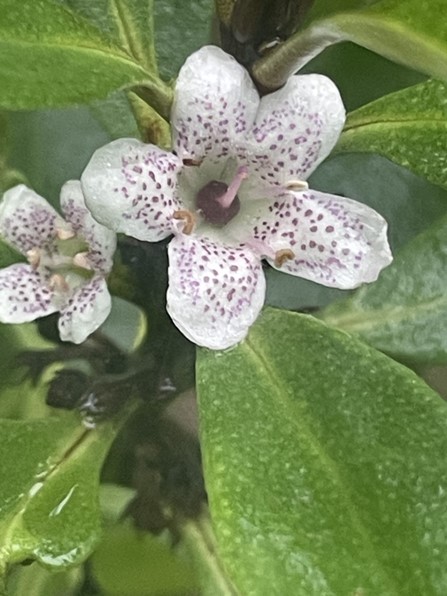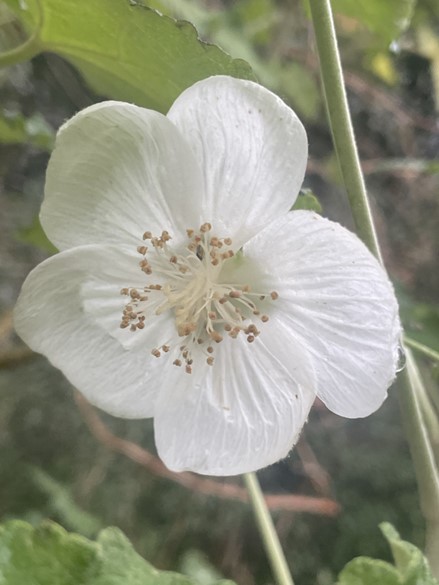April at VBG
To the north of the Olive Grove several types of citrus trees are in fruit. In the Mediterranean where these are cultivated they flower in February and fruit in winter. Our trees have been outdoors for 15 years now following the same flowering and fruiting pattern, but have yet to fill the air with the heady scent of the Jalón valley.


In the New Zealand Garden look carefully for the flowers of Myoporum laetum. This grows into a tree in its native land where it is a subject of folklore. According to Maori legend it is said to reside on the moon, banished there along with a goddess-cursing harridan and her calabash. Unusually, the flower has five petals but only four stamens, so only a single line of symmetry.

Behind the Campsis Arch is an odd collection of plants, amongst which is Abutilon vitifolium “Album”. This white flowered abutilon normally blooms in May or June, is usually short lived and prone to sudden death. On all three counts it is wrong here, flowering in the belly of winter at a grand old age of 19 having been raised from seed here at VBG.

Nearby, flowering, is the Persian Iron Tree, Parrotia persica (the red bit). It may look like a giant, but the Champion (largest in the UK) is on the Isle of Wight at Gatcombe House where it towers at nearly 19m. Ours is half that, but a fraction of the age. The lichen in the photograph is not part of the tree, but is an epiphytic composite organism made up from bacteria and algae living amongst filamentous fungus. You couldn’t make this stuff up.

Mahonia “Charity” has become ubiquitous and lurks like a dull spiky adolescent around car parks and bin stores up and down the land. In the spirit of adventure I’ve included a picture here of M. x lindsayae, a cross made in 1959 at Cambridge Botanic Garden between M. japonica and the half hardy M. siamensis. The latter was obtained from Major Lawrence Johnstone, the owner and visionary designer of Hidcote: now pickled by the National Trust. In his other garden at Serre de la Medone in the south of France he was able to grow plants unsuited to the British climate, such as tender M. siamensis. The cross brings the benefits of both parents into a hardy plant, far superior than most available Mahonia.

The exquisite Desfontainea spinosa is tricky to find near the George Richmond Walk, most of the year it resembles a diminutive holly, but in bloom its remarkable tubular flowers give the game away. In a suitable climate the shrub is incredible, but it clings to life at VBG, not being a fan of our neutral soil, dry soil and low rainfall. If only it was Chile. It falls into the “if only” category .

In the South African collection can be found Anisdontea julii from the Drakensburg Mountains. At VBG we scoured seed-lists to find new plants for South Africa in 2010, and of all the Anisodontea grown A. julii proved to be the best. It flowers freely through the depths of winter, but it’s a rare month when it has no flowers at all.

Strobilanthes glutinosa arrived at VBG via a circuitous route from the Himalayas, through various hands, legitimate and otherwise. Its value as a blue flowered perennial flowering in mid winter can’t be denied. Inthis picture, right down the throat, you can see the blue veined nectar guides which are attractive to the long tonged bee pollinators it needs. 2023 was a bumper year and we have seedlings all over the former Japanese Terraces.

Looking like a pineapple sits the slowly forming inflorescence of Echium candicans reminding us that spring is just around the corner. These flowers have been forming since October, the habit of the plant changes incrementally as we pass through the danger months for frost. If we survive unscathed these buds will suddenly elongate, covered in a spiral of blue flowers at the end of April.

Your content goes here. Edit or remove this text inline or in the module Content settings. You can also style every aspect of this content in the module Design settings and even apply custom CSS to this text in the module Advanced settings.
